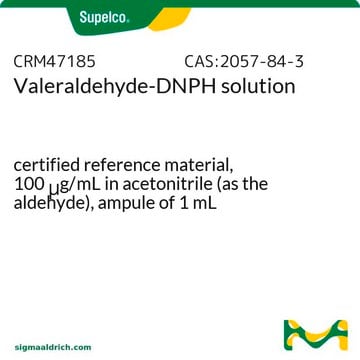All Photos(2)
About This Item
Linear Formula:
CH3(CH2)3CHO
CAS Number:
Molecular Weight:
86.13
Beilstein:
1616304
EC Number:
MDL number:
UNSPSC Code:
12352100
eCl@ss:
39021107
PubChem Substance ID:
NACRES:
NA.22
Recommended Products
Assay
97%
autoignition temp.
428 °F
refractive index
n20/D 1.394 (lit.)
bp
102-103 °C (lit.)
mp
−92 °C (lit.)
density
0.81 g/mL at 25 °C (lit.)
functional group
aldehyde
SMILES string
[H]C(=O)CCCC
InChI
1S/C5H10O/c1-2-3-4-5-6/h5H,2-4H2,1H3
InChI key
HGBOYTHUEUWSSQ-UHFFFAOYSA-N
Looking for similar products? Visit Product Comparison Guide
Related Categories
General description
Valeraldehyde also known as pentanal, serves as a precursor or intermediate to build more complex organic molecules.
Application
Valeraldehyde has been used to study its time-weighted average sampling using solid-phase microextraction (SPME) device.
Valeraldehyde is used as a gaseous standard in the study of the sorptive loss pattern for volatile compounds.
Valeraldehyde is used in flavoring compounds and as a rubber accelerator.
Signal Word
Danger
Hazard Statements
Precautionary Statements
Hazard Classifications
Acute Tox. 4 Inhalation - Eye Irrit. 2 - Flam. Liq. 2 - Skin Sens. 1 - STOT SE 3
Target Organs
Respiratory system
Storage Class Code
3 - Flammable liquids
WGK
WGK 1
Flash Point(F)
44.6 °F
Flash Point(C)
7 °C
Personal Protective Equipment
dust mask type N95 (US), Eyeshields, Gloves
Choose from one of the most recent versions:
Already Own This Product?
Find documentation for the products that you have recently purchased in the Document Library.
Customers Also Viewed
Yong-Hyun Kim et al.
Journal of separation science, 35(21), 2914-2921 (2012-10-16)
In this study, the sorptive loss patterns for volatile organic compounds were evaluated by gaseous standards containing 13 compounds (benzene, toluene, styrene, p-xylene, methyl ethyl ketone, methyl isobutyl ketone, isobutyl alcohol, butyl acetate, acetaldehyde, propionaldehyde, butyraldehyde, isovaleraldehyde, and valeraldehyde). The
Aldol condensation of cyclopentanone with valeraldehyde over metal oxides
Maki-Arvela et al.
Catalysis Letters, 149, 1383-1395 (2019)
François Fenaille et al.
Rapid communications in mass spectrometry : RCM, 18(1), 67-76 (2003-12-23)
Upon hexanal-modification in the presence of NaCNBH(3), the oxidized B chain of insulin becomes mono- and further dialkylated on both the N-terminal and Lys(29) residues. A pseudo-MS(3) study was performed with a triple-quadrupole mass spectrometer on the different modified lysine-containing
Kimberly J Grossman et al.
The European journal of neuroscience, 27(10), 2676-2685 (2008-05-01)
Odor mixtures can produce several qualitatively different percepts; it is not known at which stage of processing these are determined. We asked if activity within the first stage of olfactory processing, the glomerular layer of the olfactory bulb, predicts odor
P Scalabrini et al.
International journal of food microbiology, 39(3), 213-219 (1998-04-29)
Soybean milk, which serves as a base for a variety of beverages, contains raffinose, stachyose, pentanal and n-hexanal; the former two may be responsible for flatulence after fermentation, whilst the latter two for a beany flavour. Twenty-seven strains of Bifidobacterium
Protocols
-Tolualdehyde; Valeraldehyde; Isovaleraldehyde
Our team of scientists has experience in all areas of research including Life Science, Material Science, Chemical Synthesis, Chromatography, Analytical and many others.
Contact Technical Service















